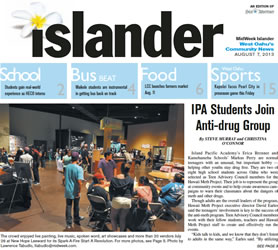Area Students Join Anti-drug Group
By Steve Murray and Christina O’connor
Island Pacific Academy’s Erica Brenner and Kamehameha Schools’ Markus Perry are normal teenagers with an unusual, but important hobby – helping other youths stay drug free. They are two of eight high school students across Oahu who were selected as Teen Advisory Council members for the Hawaii Meth Project. Their job is to represent the group at community events and to help create awareness campaigns to warn their classmates about the dangers of meth and other drugs.
Though adults are the overall leaders of the program, Hawaii Meth Project executive director David Earles said the teenagers’ involvement is key to the success of the anti-meth program. Teen Advisory Council members work with their fellow students, teachers and Hawaii Meth Project staff to create and effectively run the events.
“Kids talk to kids, and we know that they don’t listen to adults in the same way,” Earles said. “By utilizing kids with the ability to speak to their peers at their level, we just know that their message is that much stronger.”
The Hawaii Meth Project is a nonprofit that aims to reduce meth use in the state through campaigns and community action programs. The Teen Advisory Council has been an integral part of the organization’s outreach since 2010.
Perry, a Kapolei resident, began working with the Hawaii Meth Project as a sophomore when he helped organize an event for the group.
“What really stuck with me is that they had this banner in the back of their booth with all these statistics,” recalled Perry, who will is entering his senior year. “I never knew (meth use) was so prevalent here. That made me want to learn more about what this organization was about and get more involved with what it was doing.”
Brenner, too, was struck by the drug’s prevalence in Hawaii.
“Through my work on the Teen Advisory Council, I know that 20 percent of young adults in Hawaii report knowing someone who has been treated for meth use, so I see it as an ongoing problem,” she explained.
Brenner, Perry and the other council members will be leading peer-to-peer outreach about the dangers of the drug. They also will be reaching out to other teens in their schools and in their communities, as well as via social media.
“If we start targeting the younger age groups, and we educate them about the dangers of methamphetamine, we can hopefully help prevent them from even trying it before it is too late,” Perry said.
Applicants were chosen based on school performance, letters of recommendation, as well as proposals for how they plan to raise awareness about meth.
“I believe the organization has been effective in changing the perspective teens and young adults have about meth,” Brenner said. “Throughout the years, it has made a huge difference with teens, who have reported that the Hawaii Meth Project ads made them less likely to try or use meth.”
“I just think this is a wonderful opportunity to get more involved with the project and help spread the ‘not even once’ message throughout Hawaii,” Perry said. “I have heard stories about people who have tried it, and they are now addicted. Their health, their academics and their whole general motivation in life just decline rapidly. It is highly addictive, and it is scary what this drug can do to your life.”
For more details on the project, visit hawaiimethproject.org.







